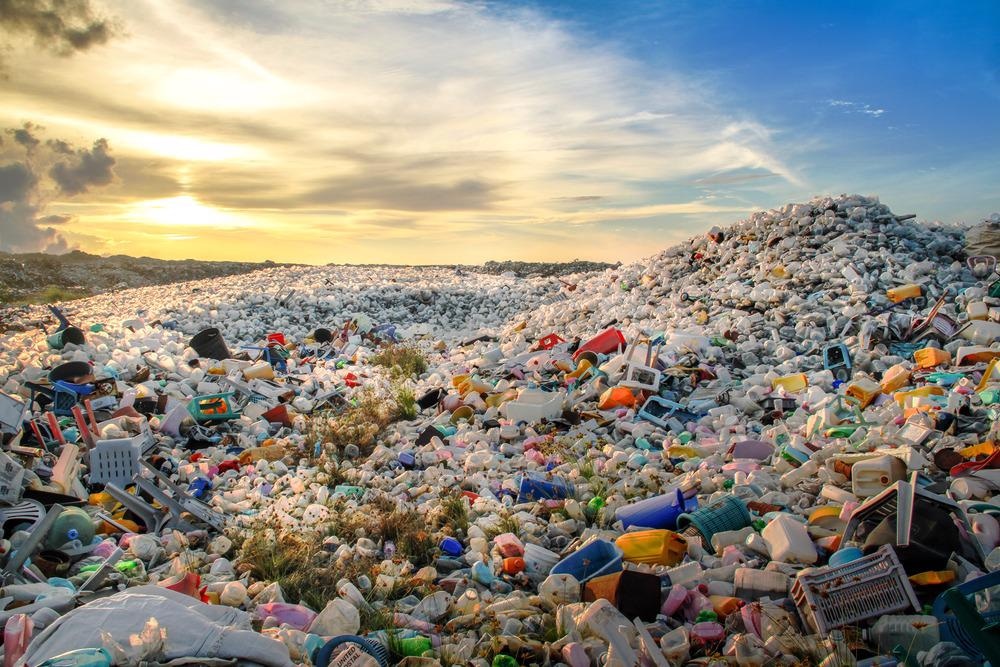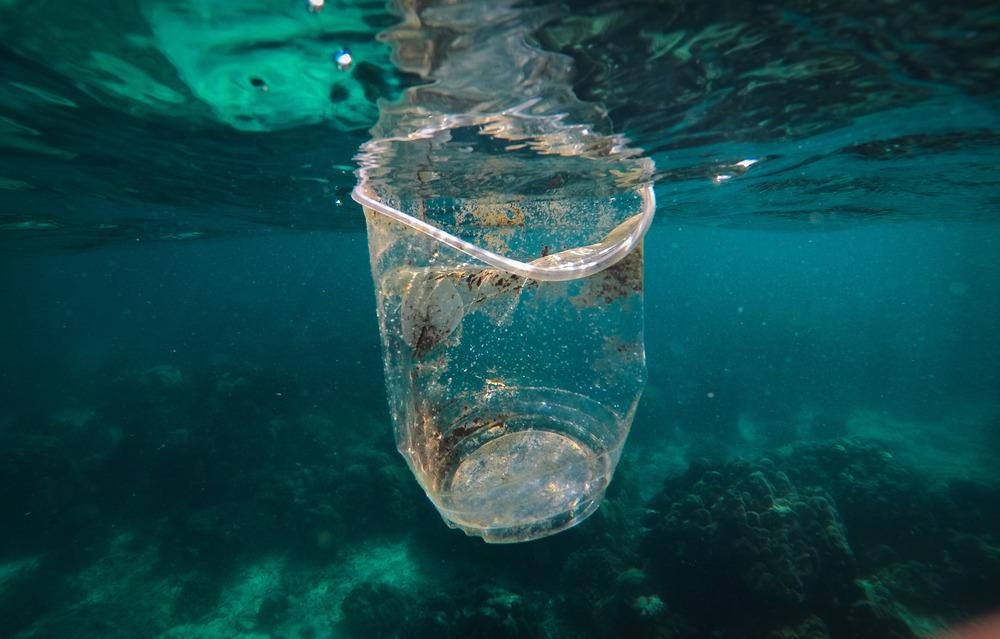To date, several different microorganisms have been found to participate in the biodegradation of various synthetic plastic materials following their isolation from the soil of plastic-dumping sites, the waste of mulch films, marine water, soil contaminated by crude oil, sewage sludge, landfills, and the intestines of plastic-eating worms.

Plastic waste is a global problem. Image Credit: MOHAMED ABDULRAHEEM/Shutterstock.com
Plastics in the Environment
The widespread use of plastic around the world is largely due to its inexpensive production costs, as well as its strong, lightweight, corrosion-resistant, and electrical insulation properties. In fact, recent estimates suggest that between 500 billion to one trillion tons of polyethylene (PE) are produced each year to meet this global demand.
Despite its advantageous characteristics for industrial purposes, the degradation of plastic takes more than 1,000 years to occur. In addition to its extensive degradation time in the environment, the burning of plastic also releases dioxides and carbon dioxide (CO2) into the environment. Taken together, plastic consumption and waste are major contributors to global warming and pollution.
Another significant environmental concern associated with plastics is the formation of microplastics, which occurs following the photodegradation of large plastic materials by the sunlight. These microplastics can contaminate both sand and water supplies, which can lead to the accidental consumption of these toxic particles by terrestrial and aquatic animals, as well as humans through the food chain. Recent estimates suggest that plastic contaminants in the aquatic environment affect at least 276 species, of which include 44% and 86% of seabirds and sea turtles, respectively.
Microorganism Degradation of Plastics
By definition, polymer degradation involves any alteration to the physical or chemical properties of the plastic material that occurs as a result of exposure to certain environmental factors like light, heat, moisture, or biological activity. More specifically, these types of polymer degradation methods can be referred to as photodegradation, thermo-oxidative-degradation, and biodegradation, respectively.
Biodegradation relies upon microorganisms like bacteria, fungi, and algae to degrade polymer materials through their metabolic activity. This form of biodegradation does not require the involvement of heat energy and can be conducted under either aerobic or anaerobic conditions. For example, aerobic biodegradation leads to the production of CO2 and H2O in the soil, whereas anaerobic biodegradation often results in the production of CO2, H2O, and methane.
Overall, biodegradation of polymers is a highly complex process that is dependent on several factors including the availability of the substrate, surface characteristics, morphology, as well as the molecular weight of the polymers.
Despite these variables, the general mechanism for the biodegradation of plastics begins with the secretion of specific plastic-degrading enzymes that vary according to the microorganism and the polymer material undergoing degradation. These enzymes then participate in adsorption on the plastic surface and are followed by the hydroperoxidation/hydrolysis of the bonds. This subsequently leads to the release of short degradation intermediates until the final byproducts of the biodegradation are produced via the tricyclic acid (TCA) cycle.

The general mechanism for the biodegradation of plastics begins with the secretion of specific plastic-degrading enzymes that vary according to the microorganism and the polymer material undergoing degradation. Image Credit: Peeraphat Theplib/Shutterstock.com
Biodegradation is Based on the Type of Synthetic Plastics
In general, the biodegradation of synthetic plastics can be subdivided into two groups: plastics with a carbon-carbon backbone and plastics with heteroatoms in the main chain. The four major types of plastics that have a backbone that only consists of carbon atoms include polyethylene (PE), polypropylene (PP), polystyrene (PS), and polyvinyl chloride (PVC). Comparatively, the second group of synthetic plastics includes materials that contain polyethylene terephthalate (PET) and polyurethane (PU).
Plastics with carbon backbone
For PE, the microbial degradation rate has been calculated to be within the range of 0.26-0.29% after two years. Since PE has an average molecular weight of 300,000 Daltons (Da), this has been a limiting factor for the microbial degradation of this type of synthetic plastic. However, pretreatment of PE in the form of ultraviolet (UV) irradiation, chemical oxidizing agents, and thermo-oxidation have improved the microbial degradation of long-chain PE.
Nevertheless, several different microbial strains have been observed to degrade PE, some of which include Serratia marcescens, two cyanobacteria of Phormidium lucidum and Oscillatoria subbrevis, the waxworms Galleria mellonella and Achroia grisella, as well as two bacterial strains of Enterobacter asburiae YT1 and Bacillus sp. YP1.
Several PS-degrading microorganisms have also been isolated from various environmental samples including three soil microorganisms of Xanthomonas sp., Sphingobacterium sp., and Bacillus sp. STR-YO. The actinomycete Rhodococcus ruber C208 has also been found to degrade PS.
Several different microorganisms have also been observed to assist in the biodegradation of PP. Following their isolation from plastic-dumping sites, Pseudomonas stutzeri, Bacillus subtilis, Bacilius flexus, Phanerocharte chrysosproium, and Engyodontium album have successfully produced degradation products of PP. Additional microorganisms that have been found capable of degrading PP include Stentrophomonas panacihumi, Aneurinibacillus aneurinilyticus, Brevibacillus agri, Breviibacillus sp., Brevibacillus brevis, Bacillus sp. Strain 27, and Rhodococcus sp. Strain 36.
Plastics with heteroatoms in the main chain
Plastics containing PET often possess a high degree of crystallinity that is within the range of 30 to 50%; therefore, these materials are often associated with a low rate of microbial degradation that takes over 50 years to be completely degraded in the natural environment. Despite these characteristics, several hydrolases have been found to be capable of hydrolyzing PET and thus support their biodegradation. These enzymes have been isolated from a wide range of microorganisms including Thermobifida fusca, Humicola insolens, Pseudomonas mendocina, Fusarium solani, Saccharomonospora viridis, Ideonella sakaiensis, and Thermobifida fusca.

Plastics containing PET often possess a high degree of crystallinity that is within the range of 30 to 50%; therefore, these materials are often associated with a low rate of microbial degradation that takes over 50 years to be completely degraded in the natural environment. Image Credit: CalypsoArt/Shutterstock.com
Conclusion
Although several microorganisms and enzymes are capable of degrading various types of synthetic plastic materials, there remains a limited understanding of how certain enzymes like depolymerases contribute to the breakdown of plastics in the environment.
Therefore, there remains an urgent need to conduct further studies in order to isolate and study plastic-degrading microorganisms. Additionally, the impact of plastic pollution on both environmental and human health should encourage the general public to transition from plastic products to more eco-friendly options.
References
- Venkatesh, S., Mahboob, S., Govindarajan, M., et al. (2021). Microbial degradation of plastics: Sustainable approach to tackling environmental threats facing big cities of the future. Journal of King Saud University – Science 33(3). doi:10.1016/j.jkus.2021.101362.
- Ru, J., Huo, Y., & Yang, Y. (2020). Microbial Degradation and Valorization of Plastic Wastes. Frontiers in Microbiology. doi:10.3389/fmicb.2020.00442.
- Mohanan, N., Montazer, Z., Sharma, P. K., & Levin, D. B. (2020). Microbial and Enzymatic Degradation of Synthetic Plastics. Frontiers in Microbiology 11. doi:10.3389/fmicb.2020.580709.
Further Reading